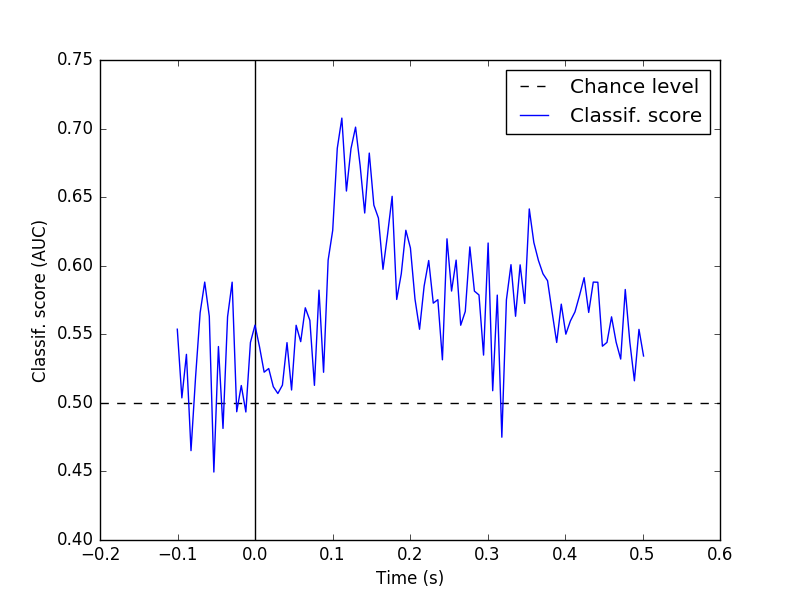Run temporal searchlight decoding on event related data¶
In this tutorial we show how to run a temporal window decoding on event related data. We’ll try to decode tools VS faces in the working memory data.
# Author: Denis A. Enegemann
# License: BSD 3 clause
import os.path as op
import numpy as np
import mne
import hcp
from hcp import preprocessing as preproc
from sklearn.preprocessing import LabelBinarizer
from sklearn.metrics import roc_auc_score
from sklearn.cross_validation import StratifiedKFold
from mne.decoding import GeneralizationAcrossTime
mne.set_log_level('WARNING')
# we assume our data is inside its designated folder under $HOME
storage_dir = op.expanduser('~')
hcp_params = dict(
hcp_path=op.join(storage_dir, 'mne-hcp-data', 'HCP'),
subject='105923',
data_type='task_working_memory')
# these values are looked up from the HCP manual
tmin, tmax = -1.5, 2.5
decim = 3
We know from studying either the manual or the trial info about the mapping of events.
event_id = dict(face=1, tool=2)
we first collect epochs across runs and essentially adopt the code shown in Computing ERFs from HCP.
epochs = list()
for run_index in [0, 1]:
hcp_params['run_index'] = run_index
trial_info = hcp.read_trial_info(**hcp_params)
events = np.c_[
trial_info['stim']['codes'][:, 6] - 1, # time sample
np.zeros(len(trial_info['stim']['codes'])),
trial_info['stim']['codes'][:, 3] # event codes
].astype(int)
# for some reason in the HCP data the time events may not always be unique
unique_subset = np.nonzero(np.r_[1, np.diff(events[:, 0])])[0]
events = events[unique_subset] # use diff to find first unique events
subset = np.in1d(events[:, 2], event_id.values())
epochs_hcp = hcp.read_epochs(**hcp_params).decimate(decim)
epochs_hcp = epochs_hcp[unique_subset][subset]
epochs_hcp.events[:, 2] = events[subset, 2]
epochs_hcp.event_id = event_id
epochs_hcp.crop(-0.1, 0.5)
epochs.append(preproc.interpolate_missing(epochs_hcp, **hcp_params))
epochs = mne.concatenate_epochs(epochs)
del epochs_hcp
Out:
The measurement information indicates a low-pass frequency of 1017.26 Hz. The decim=3 parameter will result in a sampling frequency of 169.543 Hz, which can cause aliasing artifacts.
The measurement information indicates a low-pass frequency of 1017.26 Hz. The decim=3 parameter will result in a sampling frequency of 169.543 Hz, which can cause aliasing artifacts.
Now we can proceed as shown in the MNE-Python decoding tutorials
y = LabelBinarizer().fit_transform(epochs.events[:, 2]).ravel()
cv = StratifiedKFold(y=y) # do a stratified cross-validation
gat = GeneralizationAcrossTime(predict_mode='cross-validation', n_jobs=1,
cv=cv, scorer=roc_auc_score)
# fit and score
gat.fit(epochs, y=y)
gat.score(epochs)
Ploting the temporal connectome and the evolution of discriminability.
gat.plot()
gat.plot_diagonal()
Total running time of the script: ( 0 minutes 54.662 seconds)

